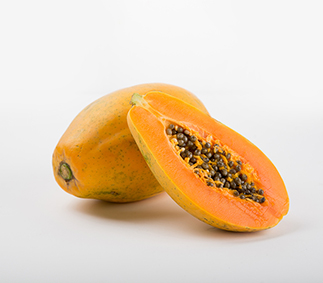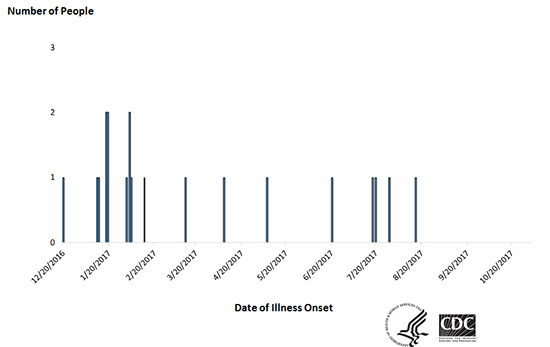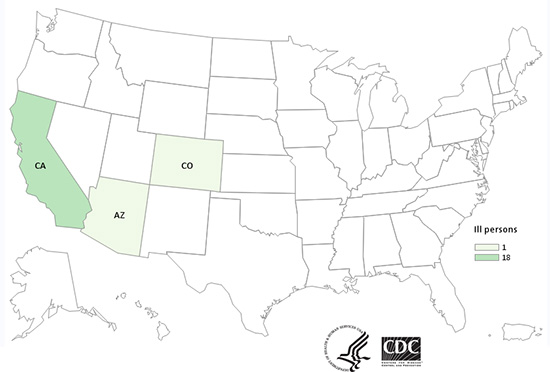2017 Salmonella Anatum Infections Linked to Imported Maradol Papayas (Final Update)
Posted November 3, 2017 3:00 PM ET
This outbreak appears to be over. This outbreak was one of four separate multistate outbreaks identified in 2017 linked to imported Maradol papayas from four different farms in Mexico. For information on the other outbreaks, please visit the Reports of Salmonella Outbreak Investigations from 2017 webpage.
- Read the Recall and Advice to Consumers, Restaurants, and Retailers>>
- This outbreak appears to be over.
- CDC, public health and regulatory officials in several states, and the U.S. Food and Drug Administration investigated a multistate outbreak of Salmonella Anatum infections.
-
Epidemiologic, laboratory, and traceback evidence indicated that Maradol papayas imported from Mexico by Bravo Produce Inc. of San Ysidro, California, were the likely source of this outbreak.
- On September 10, 2017, Bravo Produce Inc. recalled Maradol papayas packed by Frutas Selectas de Tijuana, S. de RL de CV, Tijuana, Baja California, Mexico.
- The papayas were distributed to California from August 10 to August 29, 2017.
- Twenty people infected with the outbreak strain of Salmonella Anatum were reported from three states.
- Illnesses started on dates ranging from December 20, 2016, to August 16, 2017.
- Five ill people were hospitalized. One death was reported from California.
- FDA testing identified the outbreak strain of Salmonella Anatum from a sample taken from an imported papaya at the U.S.-Mexico border.
Introduction
CDC, public health and regulatory officials in several states, and the U.S. Food and Drug Administration (FDA) investigated a multistate outbreak of Salmonella Anatum infections linked to Maradol papayas imported from Mexico by Bravo Produce Inc. of San Ysidro, California.
Public health investigators used the PulseNet system to identify illnesses that may have been part of this outbreak. Twenty people infected with the outbreak strain of Salmonella Anatum were reported from three states. A list of the states and the number of cases in each can be found on the Case Count Map page. Whole genome sequencing (WGS) showed that isolates from people infected with Salmonella were closely related genetically. This close genetic relationship means that people in this outbreak were more likely to share a common source of infection.
Illnesses started on dates ranging from December 20, 2016, to August 16, 2017. Ill people ranged in age from less than 1 year to 89, with a median age of 43. Among ill people, 85% were female. Among 11 people with available information, 10 (91%) were of Hispanic ethnicity. Among those 11 people, five (45%) were hospitalized. One death was reported from California.
Antibiotic susceptibility testing was performed by CDC’s National Antimicrobial Resistance Monitoring System (NARMS) laboratory on clinical isolates from four ill people in this outbreak. All four isolates did not show resistance to any of the antibiotics tested. In addition, WGS did not identify any antimicrobial resistance genes in isolates from 14 ill people. These findings are consistent with results from standard antibiotic susceptibility testing.
Investigation of the Outbreak
Epidemiologic and laboratory evidence indicated that Maradol papayas imported from Mexico were the likely source of this multistate outbreak.
In interviews, ill people answered questions about the foods they ate and other exposures in the week before they became ill. Ten (91%) of 11 people interviewed reported eating papayas. This proportion was significantly higher than results from a survey [PDF – 29 pages] of healthy Hispanic people in which 22% reported eating papayas in the week before they were interviewed. Five of these 10 people reported buying papayas from the same grocery store chain.
Although the epidemiologic information indicated that papayas were the likely source of this outbreak in spring of 2017, investigators could not determine the specific source of contaminated papayas and the outbreak investigation ended after illnesses stopped.
On September 4, 2017, FDA informed CDC that Salmonella Anatum was identified in an imported papaya sample. This sample came from a papaya from the farm Productores y Exportadores de Carica Papaya de Tecomán y Costa Alegre in Tijuana, Baja California, Mexico. WGS showed that the isolate from the papaya was closely related to isolates from 14 people infected with Salmonella Anatum in spring of 2017. Bravo Produce Inc. was a supplier of Maradol papayas to the grocery store chain where five of 10 ill people reported buying papayas.
After receiving FDA’s Salmonella isolate from papayas in September, CDC reviewed the PulseNet database to look for matching DNA fingerprints in bacteria from people who got sick more recently after the investigation closed in the spring of 2017. Six more ill people were identified and WGS showed that the Salmonella Anatum isolates from the papayas were closely related to the Salmonella isolates from these ill people.
On September 10, 2017, Bravo Produce Inc. recalled Maradol papayas packed by Frutas Selectas de Tijuana, S. de RL de CV. The grower of the recalled Maradol papayas was Productores y Exportadores de Carica Papaya de Tecoman y Costa Alegre in Tijuana, Baja California, Mexico.
This outbreak appears to be over. This outbreak was one of four separate multistate outbreaks identified in 2017 linked to imported Maradol papayas from Mexico. For information on the other outbreaks, please visit the Reports of Salmonella Outbreak Investigations from 2017 webpage.


